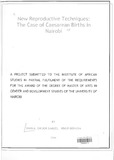| dc.description.abstract | This study investigated the role that New Reproductive Techniques (NRTs) play in widening the scope of women in enjoying reproductive health and rights. Some of these NRTs include in vitro fertilization (IVF), cloning, genetic screening, and anaesthesia management. Specifically, the study examined the social and cultural environment in which caesarean section births take place in Nairobi, exploring the decision makers in reproductive health, while questioning some usage of NRTs with regard to ethical considerations.
The study used cognitive dissonance theory as posited by Leon Festinger. Two public and two private hospitals were purposively selected for the study in Nairobi. A sample of forty respondents (32 women and 8 men) was also randomly selected. An interview guide with open ended and close ended questions, key informants and focused group discussions were the major methods used to generate data for this study. Additional data was gathered through the use of informal conversations. The data was analysed using both qualitative and quantitative techniques.
The findings of the research indicate that there are many factors that women consider in order to arrive at the decision to give birth vaginally or through c-sections. The study further reveals that most women in Nairobi do not have sufficient information that can help them make reproductive health choices that face them when pregnant. The study acknowledges the critical role that NRTs play in the management of women’s reproduction, while at the same time asserting that NRTs can be applied for self gain and other reasons other than strict medical indications
The study recommends that c-sections (especially emergency c-sections) be made readily available to all women who may need it, in order to reduce maternal mortality in the country. The study further recommends that many more lives could be saved by improving training in anesthesia and postoperative surveillance | en_US |

